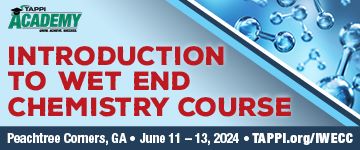 Search
Search
Use the search bar or filters below to find any TAPPI product or publication.
Filters
Content Type
Publications
Level of Knowledge
Committees
Collections
Journal articles

Magazine articles

Understanding the energy and emission implications of new technologies in a kraft mill: Insights from a CADSIM Plus simulation model, TAPPI Journal June 2024
ABSTRACT: Kraft mills play a vital role in energy transition because they have significant potential to reduce their own energy utilization and produce energy/products to decarbonize other sectors. Through biomass combustion and potential biogenic carbon emissions capture, these mills can contribute to offsetting emissions from other sectors. This research investigates the departmental and cross-departmental implications of technology upgrades on energy, steam, emissions, water, and chemicals using a CADSIM Plus simulation model. The model provides a comprehensive analysis of mass and energy balances, offering valuable insights into the benefits and limitations of each technology. The model facilitates scenario analysis and comparisons of process configurations, enabling data-driven decision-making for sustainable and competitive operations. Six high-impact technologies, including additional evaporator effects, weak black liquor membrane concentration, belt displacement washer for brownstock washing, oxygen delignification, and improvements to the pulp machine shoe press and vacuum pumps, are evaluated. Individual technologies resulted in energy savings of 1.2% to 5.4%, biomass consumption reductions of 8.6% to 31.6%, and total emissions reductions of 1.6% to 5.9%. Strategic decision-making must consider existing mill limitations, future technology implementation, and potential production increases. Future research will explore product diversification, biorefineries, and pathways to achieve carbon-negative operations, aiming to reduce emissions and secure a competitive future for kraft mills.
Journal articles

Magazine articles

Filtration efficiency and breathability of selected face masks, TAPPI Journal September 2023
ABSTRACT: Face masks have been used as physical barriers to stop respiratory infections for many years. Due to insufficient and low supply of certified masks, alternative face covers such as face shields, neck gaiters, and fabric reusable masks gained attention during the COVID-19 pandemic. However, for these alternate face masks to fulfill their intended function, they must be effective. Additionally, the level of breathability provided by the makeshift masks must be at a certain level. The work reported in this paper was carried out to determine the relationship between filtration efficiency (FE), breathability, and important physical characteristics of mask substrates. The fiber diameter of the core filter layer was determined using a scanning electron microscope. Five types of face masks (two types of N95, two types of surgical masks, and a 100% knitted cotton fabric) were tested for their FE and breathability using moisture vapor transmission rate (MVTR). The cotton knitted mask had the lowest FE (5.10%•26.47%), while the National Institute for Occupational Safety and Health (NIOSH)-certified N95 mask had the highest FE values (92.10%•99.65%). However, the cotton mask outperformed the N95 in terms of the pressure drop, meaning higher comfort. In general, the N95 face mask provided the best protection against aerosolized particles. According to the regression analysis, the fiber diameter of the mask filter substrate serves as an important predictor of FE of mask substrates. In this study, it was confirmed that fiber diameter is inversely related to the filtration ability. Results show that compact structure with finer fibers will enable higher filtration efficiency. The study lends itself to developing layered face masks to obtain optimum filters with good filtration, better fit, and acceptable comfort for the wearer.
Journal articles

Magazine articles

Modeling the dynamics of evaporator wash cycles, TAPPI Journal July 2024
ABSTRACT: Kraft pulping is a process that utilizes white liquor, composed of sodium sulfide (Na2S) and sodium hydroxide (NaOH), for wood delignification and pulp production. This process involves washing the dissolved organics and spent chemicals from the pulp, resulting in the generation of black liquor. Prior to its use as fuel in the recovery boiler, the black liquor is concentrated in multiple-effect evaporators. During the evaporation process, the inorganic salts present in the liquor become supersaturated and undergo crystallization. Fluctuations in sodium, carbonate, sulfate, and oxalate can give rise to severe sodium salt scaling events, which significantly impact the thermal efficiency of the evaporators, and ultimately, pulp production. Dynamic modeling provides insights into fluctuations in liquor chemistry in the evaporators. The primary objective of this study was to employ dynamic modeling to evaluate the effects of wash liquor recovery from evaporator wash cycles. The dynamics associated with wash cycles encompass variations in the concentrations of salts and solids in the recovered wash liquor, changes in the flow rate of wash liquor recovery, and fluctuations in liquor volume within the liquor tanks. The dynamic model was developed using Matlab Simulink and applied to the evaporation plant of a pulp mill in South America. By utilizing one month of mill process data, the model enabled the evaluation of fluctuations in liquor chemistry due to evaporator wash cycles. The developed model has demonstrated the potential to estimate the concentration of key ions responsible for scaling and to contribute to enhancements in evaporator washing strategies.
Journal articles

Magazine articles

Effects of different soda loss measurement techniques on brownstock quality, TAPPI Journal July 2024
ABSTRACT: The efficiency of the kraft recovery plant, bleaching process, and paper machine are affected when black liquor carryover from the brownstock washers is not controlled well. Measuring soda loss within a mill can vary from using conductivity, either in-situ or with a lab sample of black liquor filtrate squeezed from the last stage washer, to measuring absolute sodium content with a lab sodium specific ion probe or spectrophotometer. While measuring conductivity has value in tracking trends in black liquor losses, it is not an acceptable method in reporting losses in absolute units, typically in lb/ton of pulp. This is further complicated when trying to benchmark soda loss performance across a fleet of mills with multiple washer lines. Not only do the testing methods vary, but the amount of bound soda on high kappa pulps can be significant. This variability creates inconsistent results, and studies are needed to understand the effect of different testing methods on the pulp quality. In this study, soda loss is expressed as sodium sulfate (Na2SO4). Four different methods to measure soda content in pulp off commercial brownstock washers were studied: full digestion (FD), washing soaking overnight and washing (WSW), soaking in boiling water and stirring 10-min (SW-10), and squeeze-no wash (Sq). Total, washable, and bound sodium sulfate calculations were determined for each soda content measuring technique using inductively coupled plasma-optical emission spectroscopy (ICP-OES). Results showed bound and washable sodium sulfate amounts significantly depend on which soda measurement technique was used. In addition, the soda results were correlated with the pulp kappa numbers. As the kappa number increases, bound soda increases, regardless of the soda measurement method used. Impacts of high sodium sulfate in brownstock are also discussed.
Journal articles

Magazine articles

Editorial: Transform presentations to TAPPI Journal research papers by following basic steps, TAPPI Journal August 2024
ABSTRACT: Very often, important research findings are communicated in presentation form at industry conferences like those TAPPI holds. While this is a great way to highlight your work, it has some limitations when compared to a peer-reviewed TAPPI Journal paper. Presentations are limited to a specific event, while publishing papers in a peer-reviewed journal means that your work becomes part of scientific literature that is available to a broader audience. Also, a research paper allows for a more detailed explanation of the methods, data, and conclusions than the time-constrained format of a presentation.
Journal articles

Magazine articles

Editorial: New lignocellulosics address consumer expectations and industry prosperity, TAPPI JOURNAL February 2018
Editorial: New lignocellulosics address consumer expectations and industry prosperity, TAPPI JOURNAL February 2018
Journal articles

Evaluation of a capillaryâ??coriolis instrument for on-line viscosity and density measurements of kraft black liquor, Solutions! & TAPPI JOURNAL, March 2004, Vol. 3(3) (454KB)
Evaluation of a capillary–coriolis instrument for on-line viscosity and density measurements of kraft black liquor, Solutions! & TAPPI JOURNAL, March 2004, Vol. 3(3) (454KB)
Journal articles

Generation of streamwise vortices in a slice knife model: Can streaks be generated at the slice exit?, Solutions! & TAPPI JOURNAL, March 2004, Vol. 3(3) (655KB)
Generation of streamwise vortices in a slice knife model: Can streaks be generated at the slice exit?, Solutions! & TAPPI JOURNAL, March 2004, Vol. 3(3) (655KB)
Journal articles

Parameters for assessing fiber fractionation and their application to screen rotor effects, TAPPI JOURNAL, Online Exclusives, March 2004, Vol. 3(3) (569KB)
Parameters for assessing fiber fractionation and their application to screen rotor effects, TAPPI JOURNAL, Online Exclusives, March 2004, Vol. 3(3) (569KB)
Journal articles

Experimental and statistical investigation of drying effects on coated offset paper quality, Solutions! & TAPPI JOURNAL, July 2004, Vol. 3(7) (494KB)
Experimental and statistical investigation of drying effects on coated offset paper quality, Solutions! & TAPPI JOURNAL, July 2004, Vol. 3(7) (494KB)






